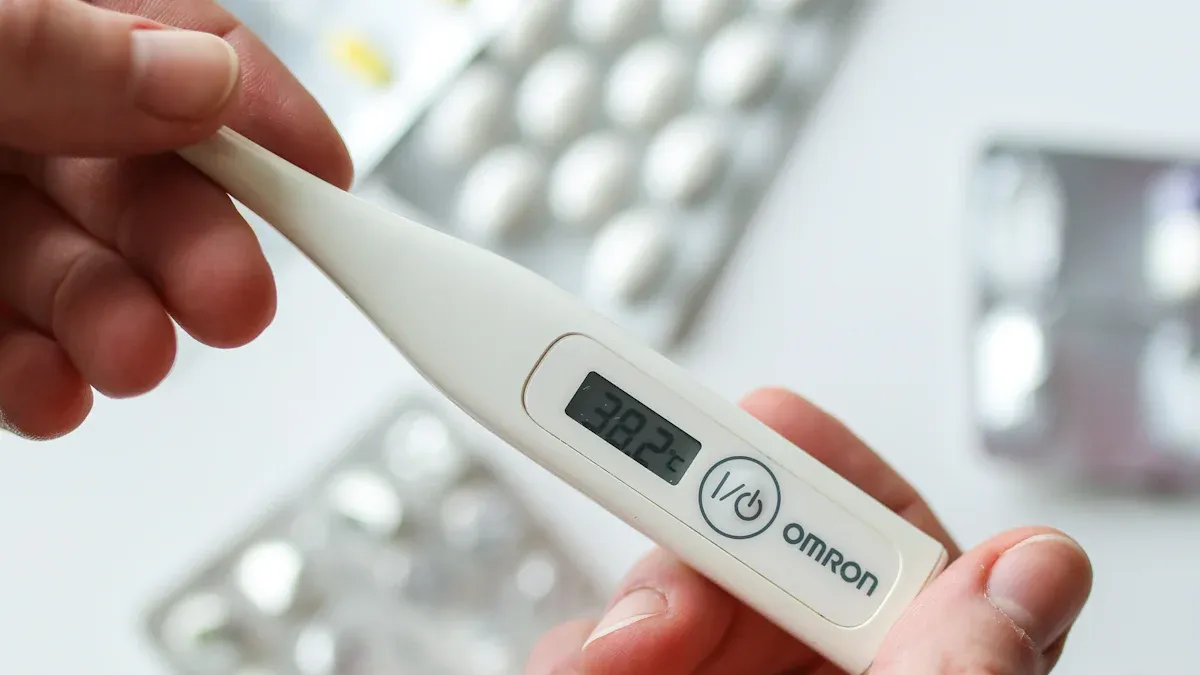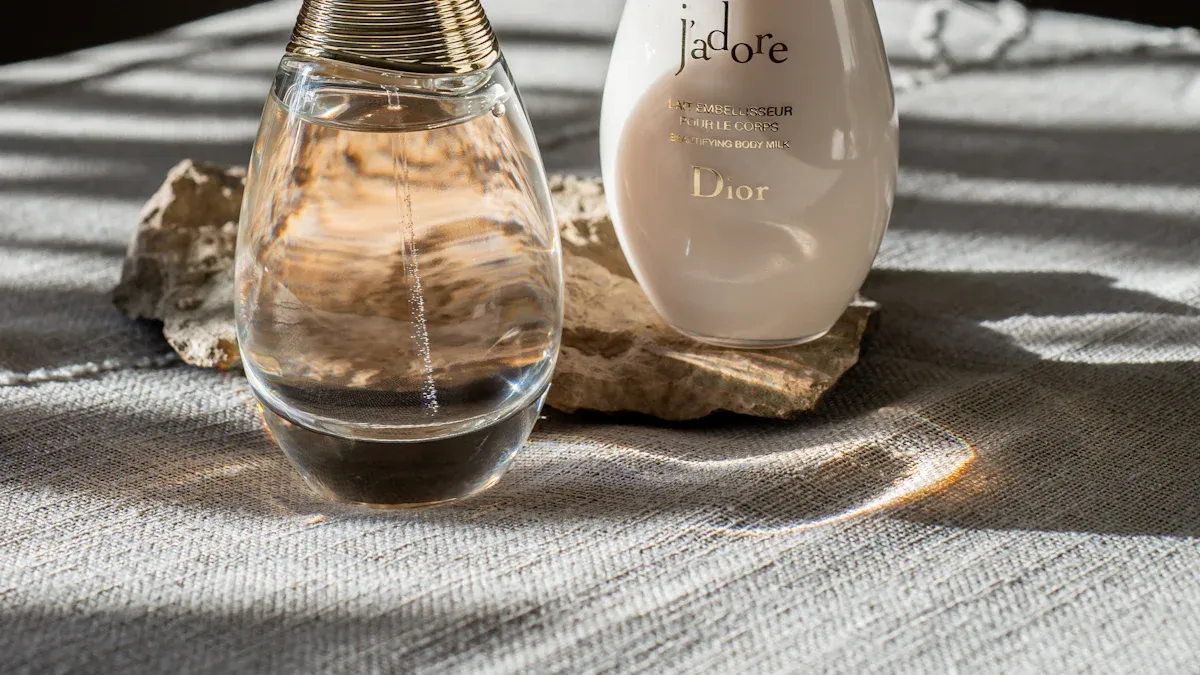
Keeping thermometers clean isn’t just about looks—it’s about health. Learning how to disinfect a thermometer properly kills germs and prevents them from spreading. Wondering how to disinfect a thermometer the right way? It’s simpler than you think. しかし, different thermometers require different cleaning steps. For example:
Infrared forehead thermometers may use covers or need disinfecting after use.
Digital oral thermometers need careful disinfecting or a cover to stop germs.
Using the right method to disinfect a thermometer kills germs and keeps it safe. Let’s learn how to protect yourself and others around you.
Materials Needed to Disinfect a Thermometer

To keep your thermometer clean, you need the right tools. Here’s a simple guide to what you’ll need for proper cleaning.
Alcohol-based disinfectant (e.g., isopropyl alcohol, at least 70%)
初め, get an alcohol-based disinfectant. Why is this important? Alcohol, like isopropyl alcohol with 70% or more, kills germs well. It works against bacteria and even tough microorganisms like Acanthamoeba culbertsoni. I always keep a small bottle nearby for quick use. But be careful—alcohol can harm materials like rubber or plastic. Check your thermometer’s manual before using it.
Cotton balls, pads, or swabs
Next, you’ll need cotton balls, pads, or swabs. These help apply alcohol to your thermometer. I prefer cotton pads since they’re easy to use and don’t leave fibers. Swabs are great for cleaning small or hard-to-reach areas, like on ear thermometers. Using these with alcohol ensures your thermometer is cleaned well.
Mild soap and water
For a gentler option, use mild soap and water. This works best for thermometers that can’t handle alcohol. I often rinse the thermometer with this method before disinfecting. Make sure to dry it completely with a soft cloth or paper towel to prevent damage from moisture.
ヒントの場合: Always check the manufacturer’s cleaning instructions. If they suggest a specific cleaner, use it for the best care.
Soft cloth or paper towels
Why use soft cloths or paper towels? They’re great for drying thermometers. I like them because they’re gentle and won’t scratch surfaces. Scratches can hold germs, which ruins the cleaning. They also soak up water fast, making drying easy.
Here’s how I dry thermometers:
After cleaning, I take a soft cloth or paper towel.
I lightly pat the thermometer dry. No rubbing to avoid damage.
If I use a cloth, I check it’s clean and lint-free. Lint can stick and make cleaning harder next time.
ヒントの場合: Use disposable paper towels for shared thermometers. It stops germs from spreading. 🌟
Soft cloths can be reused, but I wash them often. This keeps them clean for next use. Paper towels are handy when I’m in a rush. Both work well, so choose what fits your needs!
Manufacturer-recommended cleaning solutions (if applicable)
Should you use special cleaning solutions? はい! These are made for your thermometer’s material and type. I’ve noticed they help keep thermometers in good shape. Some, like infrared ones, have delicate sensors needing extra care. Regular cleaners might harm them.
これが私がしていることです:
I read the thermometer’s manual for cleaning tips.
If a specific cleaner is listed, I use it. These are usually gentle but effective.
I follow the directions, like mixing the cleaner if needed.
注記: Not all thermometers need special cleaners. If yours doesn’t, use alcohol or soap and water.
Using the right cleaner helps a lot. It keeps the thermometer working well and lasting longer. If unsure, ask the manufacturer for help. They’re usually happy to guide you! 😊
Steps to Clean and Disinfect a Thermometer
Keeping your thermometer clean helps it work well and stops germs. Let me show you how to clean and disinfect different types of thermometers.
Digital Thermometers
Digital thermometers are useful but need care to stay accurate. Here’s how I clean them after each use:
Wash with soap and water: 初め, I wash the thermometer with mild soap and warm water. This removes dirt you can see.
Wipe with rubbing alcohol: Next, I use a cotton ball soaked in rubbing alcohol (70% or more). I gently clean the whole thermometer, especially the tip.
Let it air dry: I don’t wipe it dry. Instead, I leave it to air dry completely. This avoids leftover moisture that could mess up readings.
Store safely: Once dry, I put it in a clean case to keep it free from dust and germs.
ヒントの場合: Don’t put a digital thermometer in water unless it’s waterproof. Always check the manual for cleaning instructions.
Rectal Thermometers
Rectal thermometers need extra cleaning because they touch more bacteria. Here’s my method to clean them well:
Wash with soap and water: I clean the tip with antibacterial soap and warm water to remove residue.
Disinfect with alcohol: Then, I use a cotton ball dipped in rubbing alcohol to clean the tip. I let it air dry afterward. This step kills germs.
Repeat if needed: If I want extra safety, I clean it again, especially if others use it too.
Dry and store: After cleaning, I dry it with a paper towel and store it in its own case. This avoids spreading germs.
Important: Always clean rectal thermometers before and after using them. This keeps everyone safe from bacteria.
Forehead Thermometers
Forehead thermometers are simple to use but need gentle cleaning. Here’s how I clean them:
Clean the sensor: I use a soft cloth or cotton pad with rubbing alcohol to clean the sensor. This removes oils and germs without harming it.
Don’t use water: I never rinse or soak a forehead thermometer in water. It could break the electronics.
Let it air dry: After cleaning, I let it air dry fully before putting it away.
Use covers if available: Some forehead thermometers have disposable covers. I always use a new one for each person to stop germs from spreading.
Quick Tip: Clean the sensor often to keep readings accurate and reliable.
これらの手順に従うことによって, I make sure my thermometers stay clean and ready. Whether it’s digital, rectal, or forehead, proper cleaning keeps everyone safe and healthy.
Ear Thermometers
Cleaning an ear thermometer is easy but needs gentle care. Follow these steps to keep it clean and working well:
Focus on the sensor: The sensor is the key part. Use a cotton swab with rubbing alcohol to clean it softly. This removes earwax and germs without scratching.
Wipe the outside: Take a soft cloth with a little alcohol. Carefully clean the outside, avoiding any holes where liquid could get inside.
Let it air dry: After cleaning, leave the thermometer to air dry fully. This stops moisture from causing problems.
Use fresh covers: Many ear thermometers have disposable covers. Always use a new one for each person to keep it clean and stop germs from spreading.
ヒントの場合: Don’t put an ear thermometer in water. Water can break the electronics and ruin it.
Regular cleaning keeps your ear thermometer accurate and safe. It’s a simple habit that helps with hygiene and health.
Glass Thermometers
Glass thermometers are old-fashioned but still work well. They need extra care because they’re fragile. Here’s how to clean them safely:
Wash with soap and water: Rinse the thermometer under warm water. Then, clean it with mild soap to remove dirt or residue.
Disinfect with alcohol: Use a cotton ball soaked in rubbing alcohol to wipe the thermometer. Focus on the tip since it touches the skin.
Rinse and dry: Rinse off any soap or alcohol with water. Dry it with a paper towel or let it air dry completely.
Handle carefully: Glass thermometers can break easily. Store them in a protective case to avoid cracks or chips.
Important: If a glass thermometer breaks, don’t try to clean it. Throw it away safely to avoid cuts or mercury exposure (if it’s an older type).
Glass thermometers are dependable but need careful handling. With proper cleaning and storage, they can last a long time.
How Often to Disinfect a Thermometer
Keeping your thermometer clean is not just a habit—it’s vital for health. But how often should you clean it? Let me explain.
After each use for personal thermometers
Always disinfect personal thermometers after every use. Why is this important? Even if only one person uses it, germs can stay on the surface. The thermometer tip touches bodily fluids, which can cause bacteria to grow. Cleaning it regularly keeps it safe and clean.
Here’s what I’ve learned:
Cleaning thermometers before and after use stops germs from spreading.
The World Health Organization (WHO) says to disinfect thermometers after every use, especially during sickness.
Regular cleaning helps prevent the spread of illnesses, especially when checking for fevers.
I follow simple steps to clean my thermometer. It’s quick and makes me feel confident that I’m keeping my family healthy.
ヒントの場合: Use alcohol-based cleaners (at least 70%) to sanitize your thermometer. It’s an easy way to kill germs. 🧼
Between uses for shared thermometers
Shared thermometers must be cleaned after every use. This is very important. When more than one person uses the same thermometer, germs can easily spread. Cleaning stops this from happening.
Here’s why cleaning shared thermometers matters:
Germs can stay on thermometers and spread infections if not cleaned.
Wiping with alcohol before and after use lowers the chance of spreading germs.
Alcohol-based cleaners, like isopropyl alcohol, kill bacteria, fungi, and viruses effectively.
When I use a shared thermometer, I always clean it well. This small step helps keep everyone safe and healthy.
Quick Tip: In a rush? Use disposable thermometer covers. Throw them away after each use and clean the thermometer as usual. 🌟
Special considerations for medical or high-risk settings
In medical or high-risk places, cleaning is extra important. These areas often have people who are more likely to get sick. Germs like MRSA and C. difficile can stay on surfaces, so cleaning must be thorough.
Here’s what I’ve learned about cleaning in these places:
Evidence | What It Means |
|---|---|
Germs on Surfaces | Germs like MRSA and C. difficile can stay and cause infections. |
Better Cleaning Programs | Good cleaning plans lower the risk of infections in healthcare settings. |
Teamwork Matters | Cleaning works best when everyone helps to do it properly. |
また:
After COVID-19, cleaning rules have become stricter.
Studies show many surfaces are missed during cleaning, raising risks.
The EPA lists approved cleaners to help maintain safety standards.
In these places, I suggest cleaning high-touch surfaces often and following cleaner instructions. Encouraging teamwork for cleaning also helps a lot.
Important: Use EPA-approved cleaners in medical settings. They fight tough germs and keep everyone safe. 🏥
Expert Tips for Safe and Effective Thermometer Disinfection
Follow manufacturer guidelines for cleaning and disinfection
Always follow the manufacturer’s cleaning instructions. Different thermometers are made from different materials. Some need special care to avoid damage. For example, infrared thermometers have sensitive parts needing specific cleaners. Using the wrong cleaner can harm sensors or screens. If I’m unsure, I check the manual or contact the manufacturer. This ensures proper cleaning without causing harm.
Quick Tip: Keep the manual nearby or save the manufacturer’s website. This makes it easy to find cleaning instructions quickly.
Avoid submerging non-waterproof thermometers in liquid
Never submerge non-waterproof thermometers in liquid. Water can ruin electronic parts and cause contamination. I’ve seen digital thermometers break when water enters the battery area. Instead, I clean the surface with alcohol using a cotton swab. If the thermometer has batteries, I remove them before cleaning to prevent damage.
Here’s why you shouldn’t submerge them:
Digital thermometers aren’t waterproof.
Water can permanently damage the device.
Contamination risks increase if water gets inside.
ヒントの場合: Unsure if your thermometer is waterproof? Treat it as non-waterproof to stay safe.
Store thermometers in a clean, dry place to prevent contamination
Storing thermometers properly keeps them clean and ready. After disinfecting, I place mine in a dry, dust-free case. This stops germs from settling on the surface. Leaving thermometers in humid areas can cause mold or bacteria to grow. Proper storage also protects them from accidental damage.
Here’s how I store mine:
I use a clean case or pouch.
I keep them away from sinks or bathrooms.
I check the storage spot often to ensure it stays dry.
Important: For shared thermometers, sanitize the storage area regularly to avoid spreading germs.
By following these tips, I’ve found it simple to keep thermometers clean. This routine helps keep my family safe and healthy.
Replace thermometers that are damaged or show signs of wear
Broken thermometers can’t be trusted. They might give wrong readings or spread germs. I’ve found that replacing them quickly is the safest option. Cracks, fading, or parts that don’t work are warning signs. If a thermometer isn’t reliable, it’s time to get a new one.
Here’s why this is important:
Mercury is very dangerous if touched, breathed in, or swallowed. When mercury thermometers break, the mercury can leak into cracks or under equipment. Cleaning it up is hard and risky. The best way to avoid this danger is to replace mercury thermometers with safer, non-mercury ones.
If you still use a mercury thermometer, switch to a safer type. Digital and infrared thermometers are safer and easier to clean.
How can you tell when to replace a thermometer? Look for these signs:
Cracks or chips in the glass or plastic.
Faded screens or hard-to-read displays.
Wrong or inconsistent temperature readings.
Trouble turning it on or off.
In industries like food or healthcare, strict rules ensure accuracy:
Devices are tested for accuracy when first used.
They are retested yearly or more often if needed.
I follow a similar rule at home. If my thermometer seems unreliable, I replace it right away. It’s a small cost for better health and peace of mind. 🌟
Quick Tip: Dispose of broken thermometers safely. For mercury ones, check local rules to avoid harming the environment.
Replacing old thermometers keeps everyone safe and ensures correct readings. It’s an easy step that makes a big difference. 😊
Disinfecting thermometers is a small step that makes a big difference. It keeps germs away and ensures accurate readings. I always remind myself to use the right materials, like alcohol or mild soap, and follow the proper steps. It’s not hard, and it only takes a few minutes.
Making this a habit is key. I’ve found that when I sanitize my thermometer regularly, I feel more confident about my family’s health. Why not add it to your routine too? It’s an easy way to stay safe and healthy! 😊
よくある質問
How do I know if my thermometer is waterproof?
Look at the manual or box. Most thermometers say if they’re waterproof. If you don’t know, treat it as non-waterproof to keep it safe. Waterproof ones can be rinsed, but others need wiping only.
Can I use bleach to disinfect my thermometer?
No, don’t use bleach. Bleach can harm delicate parts and leave bad residue. Use alcohol-based cleaners or solutions suggested by the manufacturer for safe cleaning.
What should I do if my thermometer breaks?
Throw it away safely. Mercury thermometers need special disposal rules. Digital ones can be recycled if allowed. Broken thermometers don’t work right and might spread germs.
Is it safe to share thermometers with others?
はい, but clean them after use. Use alcohol wipes or covers to stop germs. Shared thermometers need extra cleaning to keep everyone healthy.
How can I store my thermometer properly?
Put it in a clean, dry case. Don’t store it in damp places like bathrooms. Good storage keeps it clean and protects it from damage. Check the case often to keep it dust-free.





